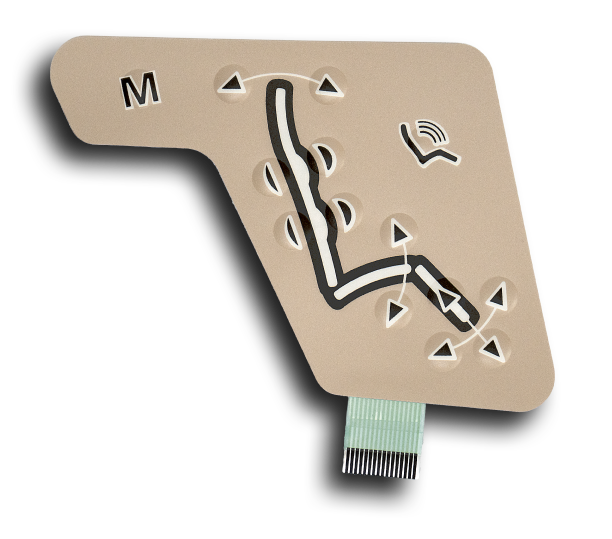Discover the Wide Variety of Industries Taking Advantage Of Membrane Switches Modern Technology
Discover the Wide Variety of Industries Taking Advantage Of Membrane Switches Modern Technology
Blog Article
The Ultimate Resource on Membrane Layer Switches Over: Layout, Functionality, and Applications
Membrane layer switches over act as an intriguing intersection of layout and capability, playing a critical function in contemporary interface throughout numerous fields. This source unboxes the essential components that contribute to their effectiveness, including visuals overlays and circuit traces, while likewise illuminating the systems behind their stress activation. As we check out the diverse applications of membrane switches, it becomes evident that their adaptability and sturdiness are important in atmospheres ranging from healthcare to consumer electronic devices. The subtleties of their layout and operational principles might disclose even deeper understandings worth taking into consideration.

Recognizing Membrane Buttons
Membrane switches are a kind of interface modern technology commonly made use of in various digital devices, defined by their slim, flexible layout and functionality. These buttons include several layers that consist of graphic overlays, sticky layers, and wiring, enabling a small and reliable user interface for users. They can be found in home appliances, clinical devices, and industrial control panels, supplying a reputable approach for user interaction.
Among the key advantages of membrane switches is their capability to stand up to contaminants such as dust and wetness, making them appropriate for settings where resilience is necessary. Their inconspicuous design permits seamless combination into various applications, while the personalized visuals overlays boost customer experience by supplying clear visual feedback. Additionally, membrane buttons can fit a range of technologies, such as tactile comments and backlighting, more enhancing their usability.
The manufacturing process for membrane changes typically involves display printing, lamination, and die-cutting techniques, guaranteeing precision and consistency in manufacturing. In general, membrane changes represent a effective and flexible service for modern digital devices, incorporating capability with visual appeal in customer interface style.
Key Elements and Style Elements
A range of essential parts and style elements collaborated to develop an efficient membrane switch. At the core, the graphic overlay offers both aesthetic and useful functions, using an user-friendly user interface while safeguarding inner parts from environmental variables. The option of products, typically polyester or polycarbonate, influences sturdiness and responsive comments.
Underneath the overlay, the sticky layer ensures the button adheres safely to the substrate, which can be plastic, metal, or glass. The spacer layer is essential, as it keeps the necessary space in between the overlay and the circuit layers, permitting effective actuation. Membrane Switches. Circuit traces, normally made from conductive ink or adhesive, are published on a flexible substrate, making it possible for electrical signals to be transferred when stress is used
Design considerations likewise consist of the setup of tactile domes or embossing that provide physical comments to the customer, boosting the total experience. Additionally, the design and spacing of the switches need to be maximized for convenience of use, making sure that customers can browse the user interface intuitively. Overall, these elements and style aspects work synergistically to produce a trusted, functional membrane switch tailored to specific applications.
Functionality and Operation Mechanism
At the page heart of efficient performance for membrane changes lies their operational mechanism, which assists in individual communication through a simple yet reliable layout. These buttons run on the concept of stress activation, where an individual applies force to a designated area of the button (Membrane Switches). This activity presses the layers of the button, completing an electrical circuit that sends a signal to the connected device
The construction normally consists of a top graphic layer, a sticky spacer layer, and a lower circuit layer, this hyperlink which jointly form a robust user interface. When stress is applied, the leading layer falls down against the bottom circuit layer, enabling conductive traces to connect. This layout not just allows clear tactile responses however additionally makes certain durability and integrity, as the buttons are typically resistant to dirt and wetness.
Moreover, the versatility of membrane layer changes permits combination with various modern technologies, consisting of LED indicators and microcontrollers, improving their functionality. By giving a streamlined interface that lessens mechanical wear, membrane switches over stay a popular option in applications varying from customer electronic devices to industrial tools, guaranteeing optimal efficiency and customer contentment across varied atmospheres.
Kinds Of Membrane Layer Switches

One more significant category is lit up membrane layer buttons, which incorporate backlighting to improve presence in low-light problems. These switches are commonly made use of in control panels and control panels where clear visibility is vital.
Moreover, there are custom-made membrane layer switches over created to fulfill details dimensional, visual, and useful needs. These modifications can consist of one-of-a-kind forms, shades, and formats, permitting smooth combination into different devices.
Applications Across Various Industries
How do membrane layer switches boost functionality throughout diverse sectors? In the medical field, membrane layer switches play a critical function in gadgets such as analysis devices and person monitoring systems, where reliability and simplicity of cleaning are extremely important.
In the automobile sector, membrane switches are commonly used in control panels and control panels, giving user-friendly controls that boost chauffeur safety and security and convenience. The consumer electronic devices sector likewise profits from their light-weight and customizable features, allowing smooth layouts for smartphones and home appliances.
Additionally, membrane layer buttons find applications in industrial automation, where they contribute to effective equipment procedure and monitoring systems. Their resistance to dust and moisture makes sure capability popular conditions (Membrane Switches). Additionally, the food and beverage industry utilizes membrane switches for devices control, where health and longevity are critical
Conclusion
In final thought, membrane changes stand for an important development in user interface innovation, identified by their one-of-a-kind design and functionality. The adaptability of membrane changes facilitates their application across varied sectors, from clinical tools to consumer electronics.
Membrane switches serve as an intriguing crossway of layout and capability, playing a crucial duty in contemporary customer interfaces throughout different industries.Membrane layer buttons are a type of individual interface technology widely used in numerous digital tools, identified by their slim, versatile design and capability.At the heart of effective functionality for membrane layer switches over exists their functional system, which assists in individual communication through a basic yet reliable layout. These buttons run on the concept of pressure activation, where a user applies force to a marked area of the switch.In conclusion, membrane layer switches represent an important innovation in individual interface technology, defined by their special design and functionality.
Report this page